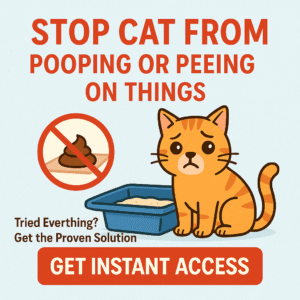Finding your kitten with crusty, goopy eyes can be heartbreaking. It often signals an eye infection or underlying illness—but with prompt care and a gentle routine, most kittens recover swiftly. This guide walks you through causes, step-by-step care, vet escalation, and prevention, all while building supportive routines like those in the Cat Spray No More ebook.
Why Do Kittens Develop Crusty Eyes?
Quick answer: Crusty eyes usually mean infection—bacterial, viral, or allergic. It could result from conjunctivitis, upper respiratory infections (URIs), blocked tear ducts, or more serious issues like corneal ulcers. Early cleaning and vet care are essential for healing and comfort.
1. Common Causes of Crusty Eyes
- Conjunctivitis: The lining around the eyes becomes inflamed, producing mucus or pus-like discharge. Symptoms include redness, swelling, squinting, and crust buildup :contentReference[oaicite:0]{index=0}.
- Upper Respiratory Infections (URIs): Viruses like herpesvirus or calicivirus often bring eye discharge alongside sneezing and nasal fluid :contentReference[oaicite:1]{index=1}.
- Bacterial infections (e.g., Chlamydophila felis): Cause thick yellow or green discharge and often affect multiple kittens in multi-cat environments :contentReference[oaicite:2]{index=2}.
- Blocked tear ducts or allergies: Allergens, irritants, or anatomical issues can lead to watery discharge and crusting :contentReference[oaicite:3]{index=3}.
- Foreign bodies, corneal ulcers, or trauma: These cause severe symptoms, including pus, pain, and possible vision issues :contentReference[oaicite:4]{index=4}.
2. Recognizing Severity
Wipe away discharge with a warm, damp cotton ball dusted away from the eye every few hours. But immediate veterinarian care is needed if your kitten shows:
- Eyes sealed shut or crust heavy enough to impair vision
- Redness, swelling, squinting, or signs of pain
- Thick yellow, green, or bloody discharge
- Persistent URI symptoms: sneezing, lethargy, not eating
- Visible trauma, ulcers, or abnormal eye surfaces
These symptoms require prompt diagnosis and treatment :contentReference[oaicite:5]{index=5}.
3. How to Help at Home: Gentle Eye Care Routine
- Keep environment clean: Provide a warm, quiet, dust-free space with fresh bedding :contentReference[oaicite:6]{index=6}.
- Warm compress: Use a warm, damp cotton ball to soften and remove crusts—wipe from inner to outer corner. Repeat several times daily :contentReference[oaicite:7]{index=7}.
- Flush with sterile saline: Use 0.9% saline or vet-recommended flush to rinse eye gently :contentReference[oaicite:8]{index=8}.
- Monitor and observe: Ensure eyes begin to clear. Home cleaning helps defined symptoms, but the underlying cause needs medical confirmation.
- Administer vet meds exactly: Use prescribed antibiotic or antiviral eye drops/ointments, like Terramycin® or Vetropolycin® :contentReference[oaicite:9]{index=9}. Continue full course — do not discontinue prematurely :contentReference[oaicite:10]{index=10}.
4. Veterinary Care: What to Expect
- Physical exam: Veterinarian inspects for redness, discharge, trauma, or ulcers :contentReference[oaicite:11]{index=11}.
- Lab tests: Swabs and cultures check for bacterial or viral causes; PCR testing may aid diagnoses like Chlamydia felis :contentReference[oaicite:12]{index=12}.
- Tear duct assessment: Blockages may be flushed under sedation :contentReference[oaicite:13]{index=13}.
- Medications: May include topical antibiotics, antivirals, steroids (if safe), oral antibiotics, or anti-inflammatories :contentReference[oaicite:14]{index=14}.
- Follow-up: Eye infections can require weeks-long treatment and monitoring :contentReference[oaicite:15]{index=15}.
5. Frequent Conditions & Tailored Care
- Herpesvirus-related infections: Often need lysine supplementation and antivirals :contentReference[oaicite:16]{index=16}.
- Chlamydia felis: Requires oral doxycycline and topical meds—treat all household cats simultaneously :contentReference[oaicite:17]{index=17}.
- Blocked tear ducts: May demand flushing and tear-stimulating ointments :contentReference[oaicite:18]{index=18}.
- Corneal ulcers/blepharitis/uveitis: Need intensive therapy—may involve referral to an ophthalmologist :contentReference[oaicite:19]{index=19}.
6. Prevention Tips
- Vaccinate: Vaccines for rhinotracheitis and calicivirus reduce URI risk :contentReference[oaicite:20]{index=20}.
- Keep litter areas cleaner: Bacteria in litter can irritate eyes.
- Reduce stress: Provide a calm, single-occupancy space with soft bedding :contentReference[oaicite:21]{index=21}.
- Groom regularly: Wipe away any tear staining or debris before crust forms.
- Isolate new or infected kittens: Prevent spread of contagious agents :contentReference[oaicite:22]{index=22}.
7. Routine & Support With Cat Spray No More
This ebook isn’t just about stopping spray—it teaches you how to build holistic routines that overlap perfectly with eye care:
- Daily health checks: Track eye cleaning, discharge levels, and behavior changes.
- Medication schedule planner: Ensures drops/ointments are applied on time.
- Environment logs: Note when discharge flares—new stresses, changes in routines.
- Reward system: Gentle praise and handling during eye cleaning encourage calm acceptance.
- Follow-up reminders: Prompts for vet rechecks and medication completion.
8. Real-Life Recovery Story
“We found 3‑week‑old Milo with crusted eyes and sneezing. Using warm compresses twice daily helped clear them enough for ointments. The vet confirmed a mild herpes‑related infection and prescribed drops and lysine. With routine and care from the Cat Spray No More planner—cleaning logs, medication reminders, and calm handling—he was fully recovered in 2 weeks and playing happily within a month.”
9. 14‑Day “Crusty Eye Rescue” Roadmap
| Days | Phase | Actions |
|---|---|---|
| 1–2 | Initial Care | Clean with warm compress, saline flush, start vet meds |
| 3–5 | Treatment | Apply meds as prescribed, clean eyes twice daily, monitor discharge |
| 6–9 | Observation | Log progress, adjust environment (warm, calm space), continue treatments |
| 10–14 | Completion | Finish full medication course, vet follow-up, transition back to play routines |
| 15+ | Aftercare | Monthly environment logs, routine eye checks, vaccination reminders |
10. Signs of Healing vs Warning Signs
- Improvement: Crust lessens, redness fades, eyes fully open by 7–10 days.
- Full recovery: Eye discharge ends, kitten bright, playful, with clear eyes in 2–4 weeks.
- Seek help if: Discharge persists or worsens after 5 days, new symptoms appear, medication runs out early—follow-up with vet.
Conclusion: Compassion + Routine = Comfort
Crusty eyes in kittens are a distressing but treatable problem. By combining cleaning, vet-directed treatment, and structure-driven care (as seen in Cat Spray No More), you protect your kitten’s vision and build trust. Early action prevents complications and supports full recovery in nearly all cases.
Download Cat Spray No More now for health logs, medication schedules, and routine-building strategies that bring clarity, control, and calm to caring for your kitten’s eyes and overall well-being.
